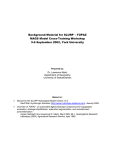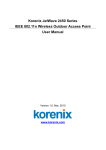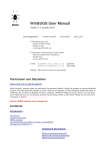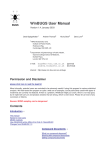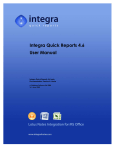Download Evaluation of Functional specification and management
Transcript
Evaluation of Functional Specification StoreShelf Comments are in red, italic font CaSenSiTiVe Consulting Electronic Inventory Management System (EIMS) Functional Specification Graham Campbell Rajkamal Dhatt Matthew Guze Allan Kumka Chris Nesmith Martin Pultz Document History Version When Who What Document edit and review, summary Finalized introduction, added to Team Structure Inserted and formatted Executive Summary, completed Team Structure. Consistent formatting throughout Edited Store Manager section, added CEO. Grammar and spelling fixes for Interface section. Sample dialog for Store Manager, changed title, and system name. Store Manager section edited. Inventory Manger done Introduction updated, minor re-formatting Management plan section completed Edited Line Worker to follow requirements. Edited Authorization management plan section to follow requirements. Wrote a few more sections. Added Basic Template and Formatting. Wrote first few sections. Initial Draft 1.13 1.12 1.11 27/01/09 26/01/09 26/01/09 Martin Pultz Graham Campbell Raj Dhatt 1.10 1.9 1.8 26/01/09 26/01/09 26/01/09 Graham Campbell Matthew Guze Raj Dhatt 1.7 1.6 1.5 1.4 1.3 26/01/09 26/01/09 26/01/09 26/01/09 26/01/09 Matthew Guze Chris Nesmith Graham Campbell Allan Kumka Allan Kumka 1.2 1.1 25/01/09 25/01/09 Matthew Guze Chris Nesmith 1.0 23/01/09 Graham Campbell Page ii 1. Executive Summary StoreShelf requires the development of an inventory management system for effective management of stock for a large scale grocery store chain. CaSeSenSiTiVe Consulting Inc.’s proposed Electronic Inventory Management System, or EIMS, will allow StoreShelf employees to more efficiently check current in-store stock. It will also help to automate and simplify stock transfers between stores, and stock orders from the warehouse. The system will update automatically after each transaction, allowing employees to view stock tallies that are never more than ten minutes out of date. This will eliminate some of the current confusion (including inadequate customer services) created by old data. Furthermore, all inventory modifications will be logged to enable audits. The final version of the EIMS will have the following basic functionalities: • A searchable database of products • The ability to automatically re-order out of stock or low-stock products (controllable) • Ability to generate sales and inventory reports based on a variety of data and statistics • Ability to request a transfer of inventory from one store to another • Ability to check out and return items • Ability to manually override stock quantities • Enable different levels of access to the EIMS functionalities based on an employee’s responsibilities and position, from cashiers to CEOs The system is meant to be used by all employees of StoreShelf in order to check the current stock of their store and other stores if necessary. However, for management purposes, the following user restrictions are suggested, and will initially apply: • Line Workers, such as cashiers and clerks, can ONLY access the search component • Store Managers can access the search component, the ordering component, and the statistics and reports component • Inventory Managers can access the search component, the ordering component, and the statistics and reports component. • The CEO can access the search component, the ordering component and the statistics and reports component. • ONLY the CEO, Store Managers, and Inventory Managers can submit a transfer request • ONLY the CEO and Store Managers can change the re-order threshold for an item • ONLY the CEO will have access to statistics and reports from ALL StoreShelf branches Comments: Store Managers can only access the search component and the ordering component for their own branch, and not for other StoreShelf branches. Page iii Table of Contents 1. Executive Summary iii Table of Contents iv 1. Introduction 2 Purpose Scope Requirements Glossary Overview – how to use this document 2. Overall Description 2 2 2 2 3 3 Product Perspective Product Functions User Characteristics Assumptions and Dependencies 3. System Requirements 3 3 3 3 4 Functionality Usability Reliability Performance 4. Interfaces 4 4 4 4 4 User and Software Interfaces Line Workers Inventory Manager Store Manager CEO 5. Management Plan 4 4 5 5 6 7 Authorizing Component Display Search Component Ordering Component Statistics Component Administration Component 6. Minimal System 7 7 8 8 8 9 9 7. Summary 10 8. Team Structure 11 Page iv 1. Introduction Purpose This document describes the software requirements for a web based Inventory Management System for StoreShelf. It is meant to be used to maintain a shared understanding of the requirements between the developers and the clients of the system. The system will allow StoreShelf employees to more quickly and efficiently check current stock. It will also help to automate and simplify stock transfers between stores and stock orders from the warehouse. The system will update automatically after each transaction, allowing employees to view current stock within ten minutes of the transaction. This will remove confusion currently experienced when actual stock levels significantly differ from listed stocks. All inventory modifications will be logged for auditing purposes. Store managers and the CEO will have access to automatically generated statistics for each store in the chain. Scope The function of the system is to facilitate highly efficient inventory management for the grocery store chain StoreShelf. The system is to be used by all employees of StoreShelf in order to check the current stock of their store and other stores if necessary. Management level employees will have access to additional actions depending on their job position. Inventory managers will be able to request an inventory transfer from another store, pending approval by the store managers. Store managers will be able to view and modify the automatic reordering threshold for each item, as well as view sales statistics and trends for their own store. Automatic reorders must be signed off by both the inventory manager and store manager, so both of these positions will be able to view and approve pending transfers through the system. The CEO will be able to view the sales and statistics for each store in the chain individually and as a whole. Comments: Automatic re-orders can only be approved by Store Managers. (Please see sections 5.2, 5.3 in the RFP) Requirements In regards to hardware and performance requirements, the Electronic Inventory Management System must: • Run on the existing terminals in StoreShelf stores which are older Pentium 2 machines running Windows XP. • Update stock levels no more than two hours after a transaction occurs. • Respond promptly to requests of all varieties or display some form of progress bar to ensure users know it is still working. • Support at least 10,000 transactions per day Be available for 99% of the time on average during primary working hours (7:00 AM to 11:00PM) and 95% of the time during non-primary hours. Comments: Our store computers are currently running on Pentium 4 machines, not Pentium 2. We currently do not foresee a need for support of over 3,000 transactions per day. Glossary EIMS – Electronic Inventory Management System Page 2 StoreShelf – Client’s Corporate Name Overview – how to use this document This document contains 8 sections, ranging from introduction and purpose, to details and a team structure. These are detailed in the table of contents. 2. Overall Description Product Perspective StoreShelf requires the development of an inventory management system for effective management of stock for a large scale grocery store chain. The system should allow easy access of current and in transit stock for line workers to relate to customers. Store managers should be able to peruse sales and current stock information, as well as make changes to the automated re-ordering threshold for each product. Inventory managers should have access to the same data as store managers, but not the ability to modifying the re-ordering threshold. Inventory managers also have the ability to request transfer of stock between stores. CEOs have the same abilities as store managers but their scope is expanded to the entire chain of stores. Product Functions The system will have this basic functionality: A searchable database of products Automatic re-ordering of products that run out of stock (this re-ordering is controllable) Ability to tabulate all data for sales and inventory into a report format Ability to request a transfer of inventory from one store to another Ability to check out and return items Ability to manually override stock quantities Multiple user types of different levels of power in the corporate ladder, from cashiers to CEOs − − − − − − − User Characteristics There are four kinds of users: Line Workers: These include cashiers, warehouse workers and floor workers. Inventory Managers: Manages the activities of purchasing and inventory control for the store. Store Managers: These people are in charge of an individual StoreShelf branch. Keeps track of the sales data and makes sure everything is running smoothly overall. − CEO: The head of StoreShelf, this tool will help the CEO track and manage corporate, from audits and costs, to monthly and quarterly sales − − − Assumptions and Dependencies - The current system is not as efficient as possible, contributing to a number of business challenges, from customer satisfaction to poor inventory management - CEO and Store Managers will need some flexibility in the software to reflect changing corporate goals - All workers have basic computer literacy, and stores have adequate infrastructure and management protocols to support a new system - Employee training will be required as part of the implementation Page 3 3. System Requirements Functionality StoreShelf will have a database that should store items by the following categories: Name Product ID (as far as the store is concerned) UPC Code Price Department Quantity Brand Number sold − − − − − − − − From this data, the system should be able to take the data and be able to arrange it in report format, showing sales and inventory trends over time. In addition, the system should be able to support a barcode scanner to easily scan UPC codes, while still being able to manually enter product codes, for cases like vegetables, which do not have UPC codes. Usability The system will be usable enough that new employees, regardless of their experience with computers, will be able to use the system with minimal training. This reduces the cost on the company to train new employees and they adapt more quickly to a new situation. Reliability The system will be created so that all faults or errors that may occur during its usage will be displayed and explained in user friendly ways, so as to pertain to the content included in the comprehensive User’s Manual, which will be included with the system itself. Performance The system will assist StoreShelf in meeting its corporate objectives, by improving real-time access to inventory, and therefore improving the chances of a customer being able to purchase the product they desire. Comments: Even if the access to inventory is real-time, you have stated that the inventory database is updated at 10 minute interval. 4. Interfaces User and Software Interfaces StoreShelf's functions should be split into the following categories, one for each type of user: Line Workers Line workers begin interacting with the system by logging on a user name and password that is global to the store. They are then presented with a search screen with search criteria. Users are notified that at least one of the Page 4 following fields is require: product name, product SKU, product price. If the user submits the search they are directed to a results screen listing the matching products, price, quantity, location in the store, the expected date of the next shipment of the item. By default the results are sorted by name. The user can change the sorting by clicking on the appropriate header. If an item is out of stock the system displays a notice. The system provides a link beside the out of stock item to a screen that shows the stock levels of that item in the five nearest stores. A line worker is not allowed to check the stock of other stores unless that item is out of stock at their store. A line worker can only access the search and search result function. If a line worker fails to enter search results they are shows the search screen again with the reminder to fill in one of the search fields. Sample Dialogs: Wendy is asked by a customer if the store has any Vitamin E in stock. Wendy logs into a terminal nearby. She clicks in the name search field and types Vitamin E, and submits the search. Wendy is then presented with search results. She sees that they are out of stock of the cheaper generic brand, but they have the more expensive name brand. She asks the customer if the name brand product is what the customer is looking for. The customer agrees and Wendy directs her to the correct section of the store. A customer asks Joe if the store has soy sauce in stock as they cannot find it on the shelves. Joe logs into a terminal nearby. He clicks the name field and enters Soy Sauce, and submits the form. Joe is presented with the search results and sees that they have no soy sauce in stock. He then looks at the stock of the five nearby stores and finds one that has it in stock. Joe then reports to the customer that they are out, but tells the customer which store has it. Comments: If an item is out of stock, the system should display a list of the nearest 5 stores that have the item, and not the stock levels of 5 nearest stores. (Please see section 5.1 in the RFP) “Location in the store” parameter does not need to be present for inventory items. Inventory Manager Inventory managers start interacting with the system by logging in with a user name and password that is unique to them. They are presented with a current stock screen for the entire inventory of the store. Inventory managers can sort the list by shortage or surplus of stock, as well as by product name. They may also reduce the list to a single department in the store as opposed to the entire store. They can also search by product name, product SKU, and product price as a Line Worker could. The inventory manager can also access the stock of a product in other stores in the chain, if there's a shortage of the product at their store. If they deem it necessary they can request a transfer of stock from one store to their own. This transfer request must be accepted by both store managers before it takes place. The Inventory Manager has no ability to change the automatic re-stocking threshold. Sample Dialogs: Frank logs into the system and limits the list to the produce department. He sorts the list by item shortage. He sees that there is a shortage of 5 goods. He selects each good and finds that some of the nearby stores have a surplus amount of 2 of the items. He then places a request to have goods transferred from the stores with a surplus to his store. Store Manager The store manager would begin interacting with the system by logging on with a user name and password that is global to the store. They are then presented with a main menu screen, where they can choose various options. These options include the search screen, the ordering screen, the report screen, and the administration screen. Page 5 Also on the menu are notifications for inventory transfer requests to be approved or rejected. The ordering screen would contain a list of transfer requests to be approved or rejected. The screen would also contain some search fields so the store manager can search for a product. Once the manager clicks “Search”, a results screen would appear that would let the manager change the automatic re-ordering threshold for any of the items found. This screen would also let the store manager create an item transfer request. The search screen would function identically to that of the Inventory Manager. The report screen would present the store manager with a list of different types or reports to print, and some fields for customization, like the date of the start and end of the report. These include inventory trends and sales trends for their store. The manager can click on a report, specify some of the fields, and click “Generate”, producing a report that they can save or print. The administration screen would present the user with the ability to change any user's username and password, creating, deleting, and editing properties such as the authorization level of user accounts. Sample Dialog: Lucy logs into the system and limits the inventory list to the frozen foods department. She finds that the TV dinners are out of stock. She proceeds to the ordering screen in order to view current item transfer and item ordering requests. She sees that an associate has put in already put in a request for transfer of this item. However, she sees that there is a request to transfer far too many frozen peas, an item that is already in stock. So, she denies and removes the transfer request. Comments: Store Manager’s credentials must be unique and not global to the store. CEO After logging in with a unique username and password, the CEO would see the same screens as a store manager, except the CEO can also specify the branch to be examined on all screens. Therefore, the CEO is able to look at the stock, approve or deny transfer requests, see reports, or customize re-order trends for any store in the company. The CEO would also have some extra report functionality in that reports are not limited to single branches; they can be specified by individual store, city, region, province, or it can be company-wide. Sample Dialog: John has a meeting with the Board of Directors and needs to make a presentation to explain why another branch must be built in Edmonton. He logs in and goes to the report screen. He prints off the sales data and the inventory trends for all branches in Edmonton combined into one report. The reports show an increase in sales but inventory keeps dropping to very low amounts, so the stores never have enough in stock. The board sees this as a good reason to build another store and they vote in favor of creating a new branch. Page 6 5. Management Plan The Inventory Management System can be broken into 6 major components: a login or authorization component to control access to the system, a display component to show functions a user may perform, a search component to view the stock level of items, an ordering component to allow items to be reordered or transferred between stores, a statistic component to display sales data, and an administration or control component to update and correct the data. These components would all share a backing database but could otherwise be independent systems. Authorizing Component The authorization system will control access to the Inventory Management System. This will be accomplished by having each user log onto the system username and password combination. After a successful login, the user is directed to the display component. - Username and password combinations will be kept in database Passwords will be encrypted with one-way encryption If a user forgets their password they can request a new one from the login screen, the request is then directed to the IT department and the user is phoned and provided with the new password. After five failed login attempts on single account at a single terminal is locked for 5 min unless a user with a higher authorization level unlocks that user The lockout case does not occur with the Line Worker user If a user is locked out, the time, date and terminal used is logged If a user enters the wrong username and/or password, they are directed to login again and shown a notice that the login failed and how many attempts they have left (if applicable) After a period with no actions from the user they are logged out automatically. The time of inactivity necessary for a user to be logged out is defined by their access level. If the user provides the correct username and password the system passes the username, current store the terminal is located at, authorization level of the user, and time of login to the display component. The authorization component monitors each logged in account and logs out accounts that exceed their inactivity period After a logout command is received the component logs the time and returns the terminal to the login screen. Display The display component provides an interface for the user to the other components of the system. It processes the data from the other components of the system and displays it the user. At any time a user may logout of the system and be returned the login screen. - After receiving the information passed by the authorization component the display checks the authorization level of the user and displays the appropriate commands Line Workers level can only access the search component The Store Manger level can access the search component, the ordering component and the statistic component The Inventory Manger level can access the search component, the ordering component and the statistic component The CEO level can access the search component, the ordering component and the statistic component In the display for each component the user always has the option to go back one screen, go back to the home screen or logout Page 7 Search Component The search component provides an interface to the central database of store inventories. Though this component users are able to see the stock level of items in stores. Which stores a user may is search is determined by their authorization level. - All authorization levels can access this component Line Worker authorization level limits the user to the in stock items of the local store only If an item is out of stock a user with Line Worker level authorization can search for the stock level of that item at only the five closest stores Store manager, Inventory Manager and CEO level authorizations can define the scope of their search by individual stores, stores within a geographical region (city, province) or search all stores The default scope of a search for the Store Manager, Inventory Manager and CEO levels is national All authorization levels can define which items are included in the search by product name, product SKU, product price Search results are sorted alphabetical by name and by default are limited to 25 items per page Any user may change the number of items listed per page After searching the results may be resorted by any of the search criteria The Store Manager, and CEO level authorizations have direct links to the sales statistics for the specified search criteria Comments: If an item is out of stock, the Line Worker should only be able to view a list of the nearest 5 stores that have the item, and not the stock levels of 5 nearest stores. (Please see section 5.1 in the RFP) Ordering Component The ordering component allows the ordering and transfer of items. It allows the automatic reorder threshold for items to be changed and automatic submits an order request when the item drops below the reorder threshold. It also allows requests for the transfer of items between stores to be generated and for transfer requests to be approved or denied. - Only the CEO and Store Manger levels can change the reorder threshold for an item The component monitors the stock level of each item and when the number of items in stock drops below the set threshold an order form is generated The order form must have the signature of someone with the Inventory Manager level and Store Manager level of the ordering store Once the order form has been completed the order is send to the warehouse for processing Only the Inventory Manger, Store Manage and CEO levels can submit a transfer request Once a transfer request is submitted it is held pending approval by store managers of both the sending and receiving stores Once the transfer request has been approved it is sent to the warehouse for processing When a user logs in and has sufficient authorization level the pending request for that store are prominently displayed Statistics Component The statistics component processes and stores the sales data for each store. The component tracks the total number of items sold per transaction, amount of each individual item sold per transaction, date and time of each Page 8 transaction, department each item comes from, and the store the transaction occurred at. This data can them be organized and reported by any of the tracked details. The Store Manager level can only view statistics related to their store The CEO level can see all stores data Data is searchable by date range, item sold, department and store Display component will generate line, bar and pie graphs as well as display the raw sales data Administration Component The administration component allows users with sufficient authorization level to create and delete users, change a user’s password, remove a lockout for a user account, and change the authorization level of a user. This component also allows for manual manipulation of the inventory of stores. - Access to this component is only available to the Store Manger, Inventory Manager and CEO level - The Store Manger level can only access the user section of the administration component and are limited to creating Line Worker and Inventory Mangers who belong to the Store Manger’s store - The user section allows users to add and remove user accounts, change the password of user accounts and change the authorization level of a user - The Inventory Manger level can only access the inventory section of the administration component and are limited to modifying the stock of the location in which they work - The inventory section allows a user to manually add and remove quantities of an item - The CEO level can access both the user and inventory section of the administration component for all stores 6. Minimal System -Limit to absolutely necessary functionality -One login per class, no timeout, basic admin, basic search -Enhancements: Extra stats, timeouts, increased admin, increased automation Comments: Please clarify in much more detail what functionality would be included in the minimal system. Please briefly describe the proposed additional features. Page 9 7. Summary By ensuring a user-friendly system, with employee category-based user permissions and restrictions, and frequent updating of sales and inventory transfers, EIMS will assist StoreShelf in more efficiently managing its sales and inventories. This will, in turn, improve performance and allow StoreShelf to meet its broader corporate objectives, including in the areas of: employee satisfaction, sales, customer service, auditing capabilities, and inventory management. EIMS will require minimal employee training, with comprehensive but user-friendly documentation that anticipates common questions and challenges, for easy reference. It should make the lives of employees easier. The EIMS system will require a database, to allow for searches and reports in a number of different ways – from product name to UPC code, and store location. This will improve sales and customer satisfaction; customers will know where the product they want is, and have some options about how to get it (having it transferred, or visiting another store). In terms of integration into StoreShelf’s management structure, a number of differing levels of permissions are inherent in the system, allowing the CEO and Store Managers with maximum flexibility, while restricting line employee access to only those functions required to fulfill their jobs. EIMS will enable automatic ordering of low or out-of-stock inventory, if and as desired, as well as inter-store transfer for items. This should reduce the costs associated with over-stock problems, as well as the loss-of-sales associated with having no stock of high demand items. EIMS will also assist with management and performance, through audit and reporting capabilities. Page 10 8. Team Structure The design and development team for this system will consist of 6 engineers, all of whom have different areas of expertise. This diversity will allow for a better product, and an efficient development process. The engineers and their areas of expertise are: • Allan Kumka: Team Lead and Object Oriented Programming Expert • Martin Pultz: Web Design Expert • Graham Campbell: Web Design Expert • Raj Dhatt: Lead Documentations Analyst and System Tester • Matt Guze: Object Oriented Programming Expert and System Tester • Chris Nesmith: Object Oriented Programming Expert and System Tester Allan Kumka will be coordinating work on all milestones. Martin Pultz and Graham Campbell will be primarily responsible for any web-based development and client liaisons on this project. Raj Dhat will be have final review of all documentation produced will be the client liaisons responsible for ensuring work completed fulfills all requirements as well as any modifications required to meet those requirements. Matthew Guze will be the primary desktop and hardware developer. Team members will have input into each milestone in order to remain up to date with the current status of the system. Page 11















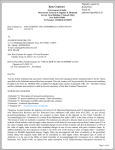
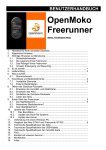

![[U3.12.03] Modélisation COQUE_3D](http://vs1.manualzilla.com/store/data/006359806_1-2c59ecda652a3b463c277cdc15704575-150x150.png)
